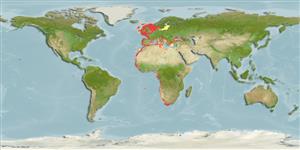Environment: milieu / climate zone / depth range / distribution range
पारिस्थितिकी
समुद्री; खारा; औशिनोड़िरोमस (Ref. 51243); गहराई सीमा 0 - 400 m (Ref. 2683). Subtropical; 62°N - 37°S, 18°W - 42°E (Ref. 54230)
Eastern Atlantic: Bergen, Norway to East London, South Africa (perhaps reaching Durban) (Ref. 10000). Also all of Mediterranean, Black and Azov seas, with stray individuals in Suez Canal and Gulf of Suez; also recorded from St. Helena (Ref. 189). Reported from Estonia (Ref. 33247).
Length at first maturity / आकार / वज़न / Age
Maturity: Lm 10.1, range 9 - 14 cm
Max length : 20.0 cm SL पुल्लिंग / अलिंग; (Ref. 189); common length : 13.5 cm SL पुल्लिंग / अलिंग; (Ref. 189); अधिकतम प्रकाशित वज़न: 0.00 g; अधिकतम सूचित उम्र: 5 वर्षो (Ref. 92145)
पृष्ठीय रीढ़ (सम्पूर्ण) : 0; पृष्ठीय सौफट रेज़ (सम्पूर्ण) : 16 - 18; गुदा कांटा: 0; ऐनल सौफट रेज़: 13 - 15; जानवरों की रीड़ का जोड़: 46 - 47. Snout pointed; maxilla short, tip blunt, reaching almost to front border of pre-operculum, not projecting beyond tip of second supra-maxilla; tip of lower jaw reaching almost to below nostril. Gill rakers present on hind face of third epibranchial. Pseudobranch longer than eye, reaching onto inner face of operculum. A silver stripe along flank, disappearing with age.
Mainly oceanic, marine species, forming large schools (see Ref. 126017:598). Tolerates salinities of 5-41 ppt and in some areas, enters lagoons, estuaries and lakes, especially during spawning. Tends to move further north and into surface waters in summer, retreating and descending in winter. Feeds on planktonic organisms. Spawns from April to November with peaks usually in the warmest months. Eggs are ellipsoidal to oval, floating in the upper 50 m and hatching in 24-65 hours. Marketed fresh, dried, smoked, canned and frozen; made into fish meal (Ref. 9987).
Pelagic spawners. Gametogenesis is continuous, multiple spawning. Spawning peaks are usually in the warmer months which makes this species a spring-summer spawner. The limits of the spawning season is dependent on temperature and is therefore more restricted in northern areas. Sex ratio: 45% female (Ref. 5580).
Whitehead, P.J.P., G.J. Nelson and T. Wongratana, 1988. FAO Species Catalogue. Vol. 7. Clupeoid fishes of the world (Suborder Clupeoidei). An annotated and illustrated catalogue of the herrings, sardines, pilchards, sprats, shads, anchovies and wolf-herrings. FAO Fish. Synop. 125(7/2):305-579. Rome: FAO. (Ref. 189)
IUCN Red List Status (Ref. 130435: Version 2024-2)
Threat to humans
Harmless
Human uses
मात्स्यिकी: उच्च वाणिज्य; ठहराव / प्रलोभन: usually
साधन
Special reports
Download XML
इंटरनेट स्रोत
Estimates based on models
Preferred temperature (Ref.
123201): 7.1 - 18, mean 10.8 °C (based on 667 cells).
Phylogenetic diversity index (Ref.
82804): PD
50 = 0.5020 [Uniqueness, from 0.5 = low to 2.0 = high].
Bayesian length-weight: a=0.00457 (0.00413 - 0.00505), b=3.10 (3.07 - 3.13), in cm total length, based on LWR estimates for this species (Ref.
93245).
Trophic level (Ref.
69278): 3.1 ±0.36 se; based on food items.
Generation time: 2.0 (1.6 - 2.8) years. Estimated as median ln(3)/K based on 47
growth studies.
लौटाव (Ref.
120179): माध्यम, न्यूनतम जनसंख्या दुगनी होने का समय 1.4 - 4.4 वर्ष। (K=0.3-1.73; tmax=6; Fec =13,000-503,000).
Prior r = 0.59, 95% CL = 0.39 - 0.89, Based on 21 full stock assessments.
Fishing Vulnerability (Ref.
59153): Low to moderate vulnerability (29 of 100).
Climate Vulnerability (Ref.
125649): Low vulnerability (9 of 100).
Nutrients (Ref.
124155): Calcium = 170 [78, 369] mg/100g; Iron = 1.21 [0.63, 2.85] mg/100g; Protein = 18.7 [17.6, 20.0] %; Omega3 = 0.976 [0.611, 1.574] g/100g; Selenium = 19.1 [9.3, 36.9] μg/100g; VitaminA = 15.5 [4.4, 51.5] μg/100g; Zinc = 1.24 [0.79, 1.84] mg/100g (wet weight); based on
nutrient studies.
